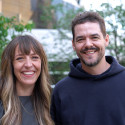Nurses keep hospital patients moving with help from UW researchers
MADISON, Wis. — Laughter may get a lot of credit, but Barbara King makes walking sound like the best medicine.
“We know it maintains our health and well-being,” says King, a University of Wisconsin–Madison professor of nursing. “It maintains our ability to breathe, our bone structure, our muscle mass. We have all the data that says getting up and walking is good. But we still put people in bed and keep them in bed.”
In hospitals, that is. Studies have shown older patients in particular spend as much as 96 percent of their hospital stay confined to a bed, and as many as 65 percent of them who are able to walk on their own will lose that ability during a hospital stay.
King and Linsey Steege, a systems engineer in the UW–Madison School of Nursing, set out to get hospital patients on their feet and walking — movement that could drastically change the shape in which they leave the hospital. They found success in a 13-week pilot study with the help of nurses in a unit at the University of Wisconsin Hospital in Madison.
“They were able to show significant changes in the number of patients that are getting out of bed, how often they’re getting up, and how far they’re walking,” Steege says “And they kept it up because everyone could feel the difference.”
The researchers published their program for mobilizing older adult patients via a nurse-driven intervention — or “MOVIN” — in the Journal of the American Geriatric Society, and the UW Hospital nurses have presented their results at high-profile conferences.
It’s hard to explain why patients stay so still when moving is so beneficial.
“This is one of the most missed nursing care opportunities. Nurses are the ones at the bedside. It is within their scope to get patients up and walking,” Steege says. “But what Barb found was that they weren’t, but not because they don’t want to.”
King points to a cultural shift in nursing that began decades ago as physical therapy practitioners became more common and emphasis on avoiding in-hospital injuries like falls grew. Nurses were also weighing professional risk, as they learned more and more about injuries — such as back problems they could develop from hefting less-mobile patients — that could hamper their careers and cause staffing issues at hospitals.
“If I’m a nurse, and I have a frail 85-year-old patient who looks like she could fall … if she has a physical therapy appointment soon, I’m probably going to wait for physical therapy to get her up first,” King says. “And there are a lot of reasons nurses reach decisions like that.”
Which made them an excellent target for intervention. It doesn’t hurt that nurses are also in the best spot for assessing each patient’s condition before walking, and benefit most from seeing a patient move around.
“How short of breath do you get? Do you look dizzy? Can you walk as far as you did last time? Do you have trouble going from sitting to standing?” King says. “That’s all data-gathering that helps nurses understand how much support patients need, and whether the patient is progressing and getting better.”
“Eventually, they had patients watching their boards and asking their nurses, ‘It’s getting kind of late, should we get that last walk in?’ ”
Linsey Steege
Steege’s engineering approach helped examine the hospital unit as a system, identifying obstacles that might keep patients from walking — like available nurse and aide time, equipment and space, training and motivation, communication and result recording — and remove or reduce as many as possible without simply trading one burden for another.
“We needed to get away from individual people doing this to an entire unit and an entire organization moving forward with the same goal,” says Steege.
In their pilot project, that meant some retraining for 18 nurses to put them squarely in charge of the decision to get a patient moving. They worked through identifying the baseline strength and health indicators a patient must show to safely get up and go, and got a refresher on realistic conditions in the School of Nursing’s simulated environments labs on how to support patients as they get out of bed and walk.
UW Hospital pitched in with funding for a nursing aide to step in and help patients walk the halls.
“And we made a simple system for recording patient movement, and put whiteboards in each room for tracking a goal — three times a day — so that the nurses and patients would see it often,” Steege says. “Eventually, they had patients watching their boards and asking their nurses, ‘It’s getting kind of late, should we get that last walk in?’ ”
Everyone reported benefits beyond improved health outcomes for patients (which King and Steege actually address in their next study).
“The patients get a change of scenery. They get to talk to someone a bit. They brighten up,” King says. “And the nurses saw psychological changes in their patients. They told us their patients were sleeping better. They were asking for less pain medication. They were happy, and they were thanking nurses for getting them walking.”
And that long list of good results made work more rewarding for the staff, who took ownership of the task just as the researchers had hoped.
“Burnout and turnover of nurses is a problem, especially in a general medicine unit like the one that took on this challenge,” King says. “But what the nurses told us was they were more excited to come to work, and felt really fulfilled at the difference they saw from the effort they made to get their patients moving.”
Tags: health care, research, School of Nursing




